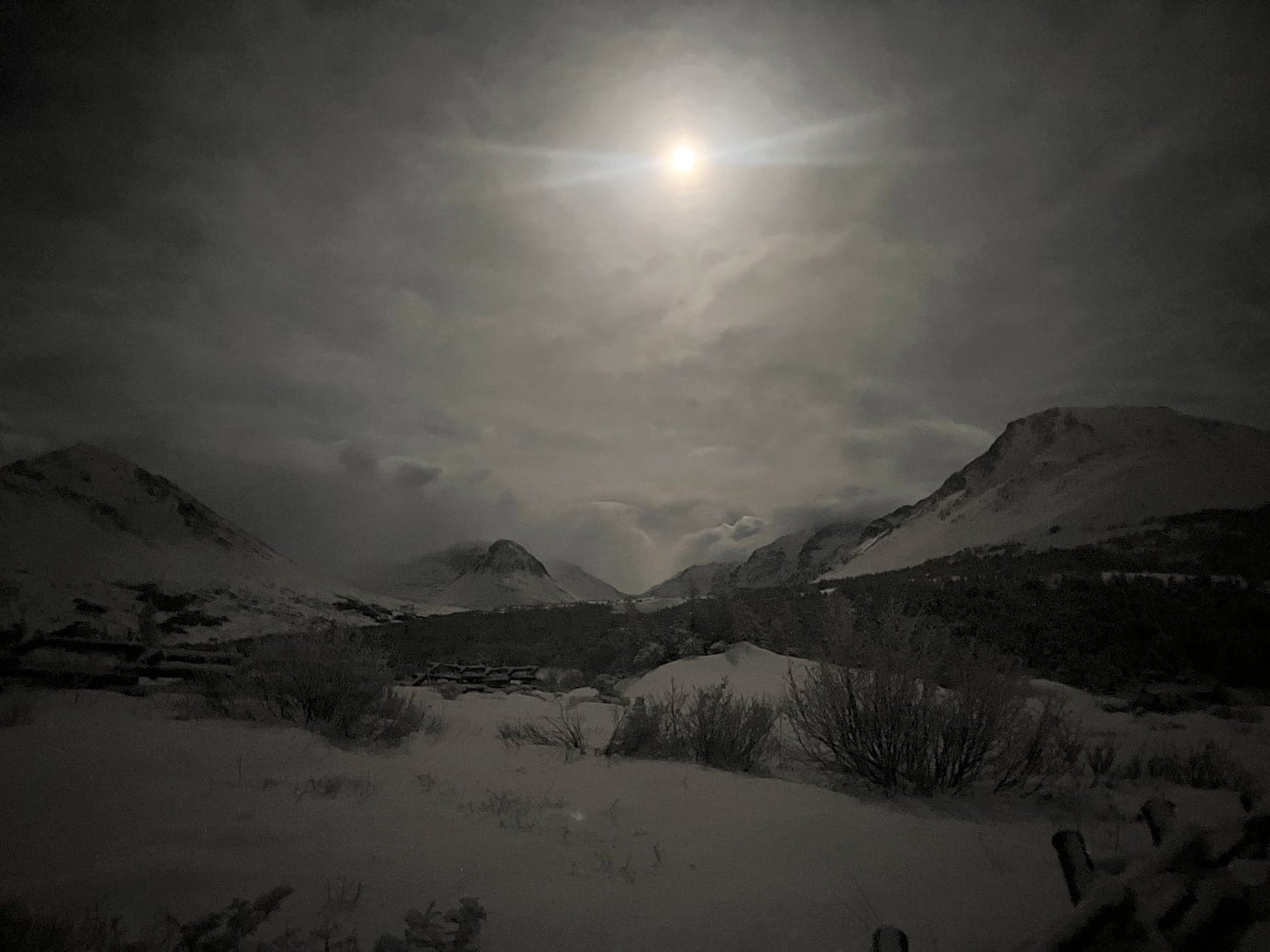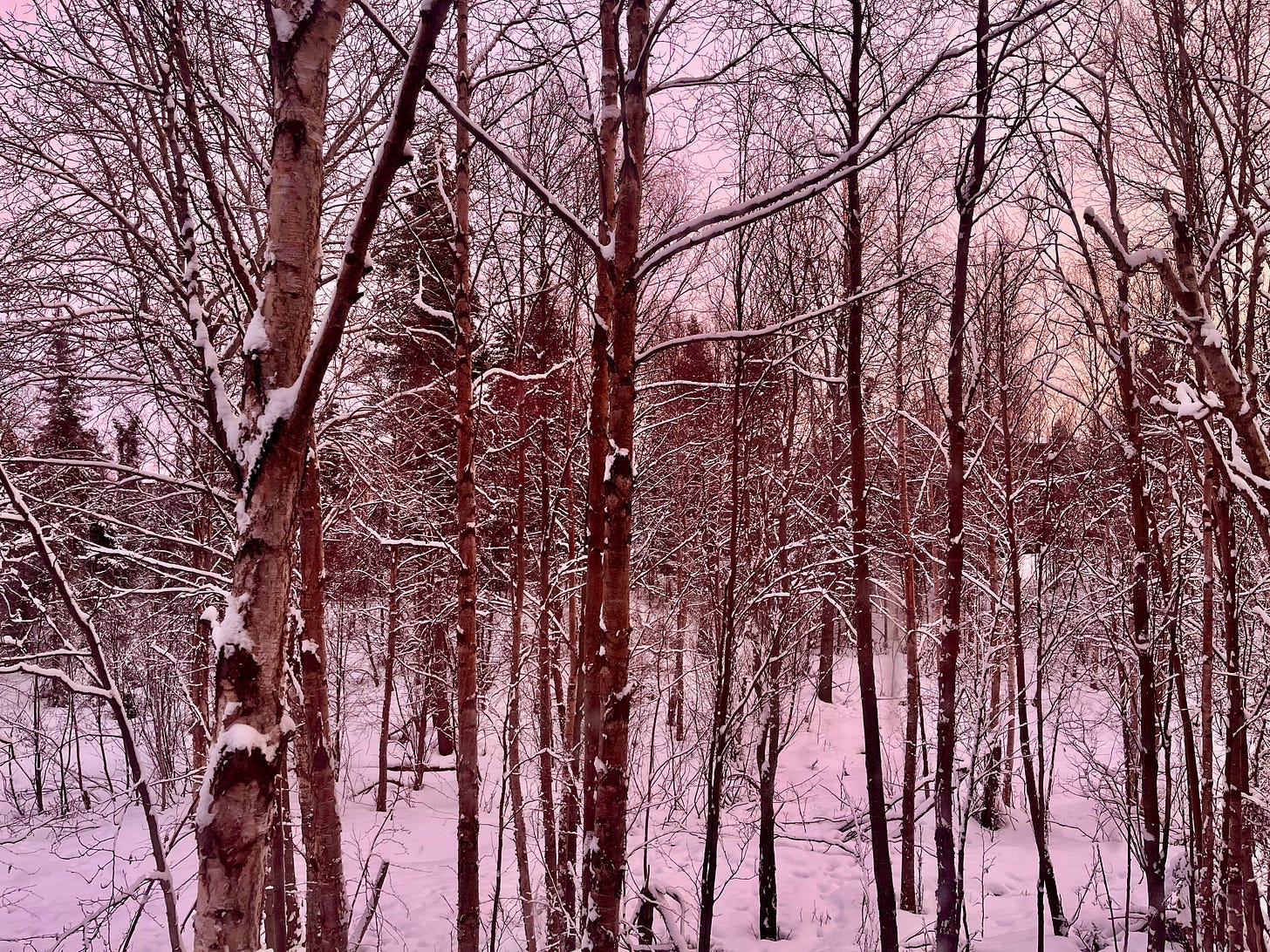It snowed again recently after more than a week of temps that were up to 9 degrees warmer than average. Much was melting, the trees bare. Now the snow returned making everything quiet again in its soft cold beauty, blank pages waiting to be written on with the tracks of magpie, fox, vole, dog, moose. And just in time for a full moon to illuminate—the snow moon.
There is that compulsion, when faced with a field of unmarked new snow, to want to stamp your own track on it. Especially with a full moon, the snow reflecting its silver light, bleaching the landscape into monochrome.
Or maybe it’s that we’ve been conditioned to want the world to know we were here. To walk on a field of snow like a blank page, to keep our story visible. But maybe that inclination to enjoy walking across a new field of snow is more a desire to be a part of the world than about a need to claim it for ourselves—of a delight in being part of it, to be assured somehow that we too have a place in such beauty.
When you travel into ‘wilderness’ we’re told to leave no trace. To leave no trace on places that have been designated and remade into a never-traced, mythic Western white imagination.
But all lands have had the steps of countless generations of humans, let alone animals, plants, minerals, soil, storm, wind, snow. All elements are a part of something that is very much traced—drawn into a landscape of dwarf birch, glacial silt, rivers, beaver dams. Actions of lives unconcerned with whether or where a trace is left, because they are all a part of it. There is no blank page to observe as separate, to leave a footprint on. There was never a blank page to begin with.
It’s an irony that while we’re warned to leave no trace in a wilderness that makes no room for human life, we’re also told to think about what kind of legacy we want to leave—as if we are, again, in control of a blank page. Find your calling, make your mark, leave your name, your heirs, your art.
We’re told that family lines end with a generation that fails to reproduce a son—that anxiety of a family name ending. But what does that really mean? My name, as I’ve written about before, is chosen for us when we’re born. And while my family name has become a part of my identity, it’s a name that has been carried through generations by men. What legacy did the women—who also had their father’s or husband’s names—get to leave? Far too many of them left no trace on pages full of ink, written upon by white men, their children traced only to their father’s name.
Mountains and places have also been given the names of (mostly white) men. Places that were known and reckoned for generations for what they represented, what they offered—a creek known for its run of salmon in spring, or an estuary where the creek water turns into brackish reeds. Mountains and rivers that are the largest in the region. But now maps record the names given by European men who buried a jar of coins on a point of land and claimed dominion over it. Or the names of men who never set foot in the places that carry their names. These legacies of empire are just beyond where I write. I so wish they were not.
In 1903, Mary Austin wrote in the preface to her book, Land of Little Rain:
I confess to a great liking for the Indian fashion of name-giving: every man known by that phrase which best expresses him to whoso names him…No other fashion, I think, sets so well with the various natures that inhabit in us, and if you agree with me you will understand why so few names are written here as they appear in the geography. For if I love a lake known by the name of the man who discovered it, which endears itself by reason of the close-locked pines it nourishes about its borders, you may look in my account to find it so described. But if the Indians have been there before me, you shall have their name, which is always beautifully fit and does not originate in the poor human desire for perpetuity.1
Austin could see beyond the norms that would prop up settler ideals of a frontier, of a land waiting to be claimed. She wrote over 30 books and 250 articles. Yet her work is out of print and largely forgotten. As Kate Silber wrote in an article on Austin:
She wrote about the mind-clearing power of open spaces in a time of rapid industrialization. She championed the rights of women on issues such as birth control and suffrage. She advocated for better treatment of Native Americans, immigrants, and other oppressed groups. But in contrast to some of her contemporaries, such as Aldo Leopold and John Muir (with whom she publicly sparred), Austin’s work was largely forgotten after her death, in 1934.
“Mary Austin said what she thought, and people don’t like that in women—now or then,” says Melody Graulich, a retired professor of western American literature and an expert on Austin’s work and life. “There have always been these women who have pushed the envelope, but we forget every generation.”
What legacy can be left if the world insists on silencing those who expect more of the world? Legacy too easily becomes the means to keep an oppressive status quo.
I think about ideas of legacy because as a writer, there’s a running dialogue in my head at all times about whether what I do has value if it’s not paid by a living wage, if it hasn’t found a home within the pages of a book.
I think often of how Emily Dickinson felt it was enough to keep her poems for her closest letter friends—and yet ended up with a legacy that continues to grow. I wonder if she ever imagined—or would appreciate—such a legacy.
I think of Margaret Cavendish, who declared her intentions for a legacy with clear fervor, desiring fame above all else. In her preface to what many consider the first science fiction, The Blazing World, Cavendish writes:
I am not covetous, but as ambitious as ever any of my Sex was, is, or can be; which is the cause, that though I cannot be Henry the Fifth, or Charles the Second; yet, I will endeavour to be Margaret the First.
She also wrote in another work, Philosophical Fancies, that
if any like my fancies when they’r read, / My times rewarded, though my body’s dead.2
And yet over twenty volumes of her work have been out of print since the century she wrote. Scant biographies repeated ideas of her as “Mad Madge,” with the first book-length biographer of her work in 1918 claiming that she was “more warped and lopsided than modern psychology tells us that we all are,” and only praising the biography she wrote of her husband. By the time Virginia Woolf wrote of Cavendish a decade later in A Room of One’s Own, she repeated the legacy of Cavendish as an eccentric, lamenting that: “There is something noble and Quixotic and high-spirited, as well as crack-brained and bird-witted, about her.” By 1988, a biography of Cavendish wrote that “only one of her books has been reprinted for sale to the general public since her death”—and that one book, of course, was the biography of her husband.3
I don’t know how I would live without being able to read the words of women like Austin, Dickinson, Cavendish. To feel connected to so many who felt the unignorable pull to create, to share secrets and wisdom and questions and outrage and love for the world in their pages. I think of the women writers and other marginalized artists who left a legacy outside the limits that would have denied them their authentic voice, of how fiercely I believe their voices should be known. Women who wrote about science through poetry, and those who wrote poetry that didn’t match the staid, sentimental verse of the time. I want these and other marginalized voices and stories to become part of our landscape.
Maybe a legacy is less about perpetuity and more about how the world responds to the tracks you leave. That it can be what connects one life to another, rather than declares, names for others, and keeps for itself. Something that reaches out to us from earlier times that leaves traces in our own pages, thoughts, bodies. Something that can exist beyond its own time for just a while before it seeps into the landscape.
That’s where I rest when I think about the question of writing, of legacies: a wish for someone to find and wonder about the tracks you left in the snow after the night’s turn, noticing them before the sun grows stronger and melts them into the earth, or the branches of the birch, and stays carried into their lives in a small way.
Because a legacy can also be as small and as beautiful as being missed by someone when you leave the room.
Austin, Mary. 1903. The Land of Little Rain. Reprinted by Aeterna Publishing. p. i
Peacock, Francesca. 2024. Pure Wit: The Revolutionary Life of Margaret Cavendish. Pegasus Books. p. 269
Quoted in Robbins, Michael. 2019. “The Royally Radical Life of Margaret Cavendish.” The Paris Review Blog.













"It’s an irony that while we’re warned to leave no trace in a wilderness that makes no room for human life, we’re also told to think about what kind of legacy we want to leave—as if we are, again, in control of a blank page. Find your calling, make your mark, leave your name, your heirs, your art."
It's a further irony that those who would bid us to leave no trace are those who left a legacy in the names of the wildernesses, peaks, and rivers. And that my matrilineal line left no trace in the family tree, their legacies assigned to the men.
There's more to unpack with each read. Bravo, Freya.
For Filipino naming tradition, our middle names are our mother's maiden last name.
I acknowledge, though, that it is still carrying a patrilineal lineage because she had her father's last name. But, unlike the Western style, we are able to trace our mother's side because of our middle names.
Last names for Dads
Middle names for Moms
So the children would have the same middle names and the same last names if they came from the same set of parents.
It was a foreign concept for me when I came to the US when I realized that Americans had unique middle names from their siblings. My cousins who were born here kept the Philippine naming convention if their mothers are also Filipinas.
Prior to the arrival of Spain, female in Philippine society had much higher status - it was reduced in the 1500s but there are still strong signs of it with the family structures nowadays.
For indigenous tribes that did not assimilate and convert to Christianity, they carried the names of whomever they wanted - making it a nightmare for the Census bureau. 😂🤣
For my family, women who marry refuse to change their last names so they keep both mother's and father's names instead of taking their husbands.